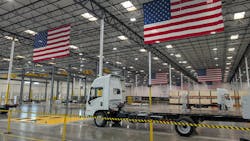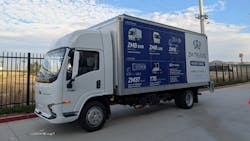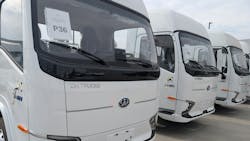ZM Trucks CEO: Fleet EVs are about TCO, not the environment
Key takeaways
- New U.S. OEM ZM Trucks prioritizes demonstrating TCO/ROI (total cost of ownership/return on investment) for electric work trucks, not environmental benefits, as EV incentives decline.
- ZM is a subsidiary of Asian vehicle manufacturer ZO Motors, which has been around for 23 years and has built trucks and buses with more than 120 million miles on the road. ZM Trucks aims to distinguish itself from failed U.S. EV start-ups.
- ZM opened a new 210,000-square-foot plant in Fontana, California, that targets 400 electric truck builds by year-end, 1,200 in 2026.
FONTANA, California—It’s a different world today than when Joost de Vries used trucking’s biggest clean technology show in 2024 to announce that his Japanese zero-emission OEM would succeed here in the U.S., where other new names failed to scale up and grow.
De Vries, the ZM Trucks chief executive, stresses that his company isn’t selling the environmental benefits of its expanding Class 4 to 7 portfolio. “Customers are starting to understand that there is an ROI if you go electric,” he told FleetOwner during the OEM’s North American grand opening celebration on August 28. “It has nothing to do with the environment. Nobody in our industry is a tree-hugging extremist. We don’t even talk about emissions other than one line item at the back of our presentation—because it doesn’t count for the customers we sell to.”
He said ZM would be successful on this side of the Pacific if it could get its equipment costs to parity with traditional work trucks “with a little government assistance.” That federal assistance is dwindling since President Donald Trump signed the One Big Beautiful Bill Act, which winds down the Biden Era federal EV tax credits. The Trump administration has quickly worked to dismantle years of decarbonization regulations that had built the transportation industry up toward a seismic shift.
ZM Trucks focuses EV strategy on fleet total cost of ownership and ROI
But that shift continues to be pushed further into the future. This summer, ACT Research downgraded its forecast for zero-emission truck adoption rates to 8% in 2030, down from the 19% it had forecasted for the same period in March. Ann Rundle, VP of electrification and autonomy for ACT, expects more revisions to its forecast in September as California-based decarbonization regulations that other states planned to mimic get delayed or rewritten.
Regulatory rollbacks are allowing traditional OEMs to focus on tried-and-true internal combustion equipment (along with some EVs), while few domestic commercial EV startups have found their footing after countless companies made splashy promises in recent years.
Trump’s sweeping tariffs on materials needed to build trucks are another geopolitical hurdle that sprouted up since ZM announced its North American plans during the Advanced Clean Transportation Expo in May 2024.
“But we still brought it in the way we said we would two years ago,” de Vries said of the regulatory and supply cost headwinds. “I think that’s really the message: You can’t make decisions like this on a (presidential) administration timeline. The market for passenger car electrification is going down. That’s very clear in Europe, here, everywhere. On the B2B side, on the commercial side, the acceleration is still going up.”
See also: Roeth: Leading through uncertainty
De Vries emphasized that his company’s long-term vision for fleets is centered on return on investment and total cost of ownership, rather than eliminating tailpipe emissions. His company, which started as ZO Motors in Asia, has already built 60 ZM8 work trucks, which can be spec’d between Class 4 and Class 6, here at its new Inland Empire assembly plant and North American headquarters, about 60 miles from the ports of Los Angeles and Long Beach. The new facility spans 9.67 acres and features a 210,000-square-foot factory floor.
While ACT Research pushed back its electric truck adoption and industry-wide TCO savings projections, Rundle noted during ACT’s August conference that EV yard spotters are already seeing savings, and medium-duty EV TCO savings would arrive before the decade’s end. Though ACT’s forecasted ZEV adoption rate has fallen during the Trump administration, it still expects some, albeit slow, growth in the market.
“As we start to see that adoption rate pick up, it’s going to be in these lower GVWs because their TCO proves it,” Rundle said August 21. “If I’m buying a truck, I’m not buying it because I’m being forced to from a regulation … I’m only buying it because it makes sense that I’m going to get a better ROI.”
ZM Trucks enters U.S. market with proven zero-emission fleet technology
At its potential peak, de Vries said the new ZM Trucks assembly plant could build three trucks per hour. He told FleetOwner he projects it to build 400 electric trucks by year’s end and around 1,200 in 2026.
The OEM drew hundreds to the celebration, including local politicians who were excited about the jobs the plant is creating (more than 100 to build out the campus and 69 full-time employees working there now), just 88 weeks after ZO first decided to launch a North American nameplate. Along with the medium-duty EV, ZM offers a T75 terminal tractor, and it plans to add a larger Class 7 EV to its North American offerings. It also sells electric and hydrogen fuel-cell buses in Asia.
The new-to-the-U.S. OEM made its goals clear during the late August celebration: It’s about cost, not emissions. “We need to sell on cost,” de Vries told FleetOwner. “And if we can get to that parity—still with a little government assistance—but if you can get to that parity, we’re going to be fine. I mean, we can sell electric trucks in Cambodia for God’s sake. And in Iraq, which is an oil-producing country. And in Algeria. There are markets where we are cost-competitive without government subsidies.
“The U.S. is a little different because the content that the U.S. requires makes the truck pretty expensive,” the CEO continued. “But Vietnam, Cambodia, Malaysia are markets where we are today, and we’re fighting diesel straight on with no incentives there. So, it’s possible that parity is there in other parts of the world.”
And unlike other U.S. commercial zero-emission startups, de Vries said he’s not going after large fleet orders. He is looking for small fleet customers who could find that adding one to five EVs could bring their operating costs down.
Parent company ZO Motors, founded 23 years ago, builds a zero-emission truck or bus every six minutes globally, he noted. “We have 120 million miles of history on our platforms. Every truck we produce has 1,500 data lines, 24/7 connectivity. If a truck burps in Vietnam, I know it before the driver does in Vietnam. This is mature technology. This is 20-year-old technology.”
His American challenge is not coming across as one of the several zero-emission commercial vehicle start-ups that burst onto the scene this decade, only to fizzle out and let down the early-adopting fleets that invested their capital.
About the Author
Josh Fisher
Editor-in-Chief
Editor-in-Chief Josh Fisher has been with FleetOwner since 2017. He covers everything from modern fleet management to operational efficiency, artificial intelligence, autonomous trucking, alternative fuels and powertrains, regulations, and emerging transportation technology. Based in Maryland, he writes the Lane Shift Ahead column about the changing North American transportation landscape.




